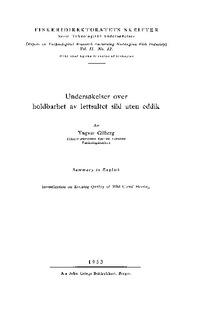| dc.contributor.author | Gilberg, Yngvar | |
| dc.date.accessioned | 2013-05-16T07:19:38Z | |
| dc.date.available | 2013-05-16T07:19:38Z | |
| dc.date.issued | 1953 | |
| dc.identifier.issn | 0078-186x | |
| dc.identifier.uri | http://hdl.handle.net/11250/130523 | |
| dc.description.abstract | The present paper presents the second part of an investigation on the efficiency of different preservatives for prolonging the storage life of light salted (15 %) herring cured without vinegar. The effect is evaluated according to the method described in part I where the rate of production of TMA-N is considered as indicating the bacterial activity and of NH3-N as indicating the activity of the proteolytic enzymes. The preservatives used were Nipasol (Nipa), Sodiumbenzoate (Nabenz.), Magnesiumbenzoate (Mgbenz.) and Hexamethylenetetramine (Hexa) as well as combinations of these preservatives individually with small amounts of calciumchloride (CaC12) calsiumacetate (Caacet.), magnesiumchloride (MgC12) octylgallate and sodiumhexamethaphosphate (Hexameta). Combinations with CaC12 gave a noticeably stronger effect than if the preservative was used alone. MgC12 gave no added effect. The importance of the Ca-ions in increasing the preserving effect was demonstrated by a combination of Nipa with Hexameta which functions as a Ca binder. The combination showed noticeably higher values for both TMA-N and NH3-N than for Nipa alone. A combination of an antioxydant-octylgallate with a preservative - Nipa- was found to have no stronger effect than the preservative alone. This is in contrast to the result achieved at an acid pH as shown in part I of these investigations. 0.27 % (of total weight of herring X brine) Mgbenz. was more effective than the same amount of Nabenz. especially regarding the bacteriostatic action. 0.13 % Mgbenz. combined with 0.035 % CaC12 gave the same effect as when 0.27% Mgbenz. was used alone. 0.1 % Hexa was found to be somewhat less effective than Nipa in regarding the development of TMA-N but noticeably stronger in retarding the production of NH3-N. The same amount of Hexa when combined with 0.073 % CaC12 was in effect equal to 0.27 % Mgbenz. A parallel test with 0.1 % Hexa diluted in a pure 15% sodiumchloride brine showed that 20 mg NH3-N was split off per 100 ml against 26 mg NH3-N in stronger acid solution (part I). The preserving effect is accordingly also at a more neutral pH due to formation of formaldehyde. The following combinations of preservatives were found to give a very good effect when used in a concentration of 0.22 % of total weight of herring and brine: I. 21 % Nipa, 54 % Mgbenz., 25 % CaC12 II. 21 % Hexa, 54 % Mgbenz., 25 °/o CaC12 When II was added to the brine and the herring was stored in the brine at 37°C for 13 days, the first sign of an offensive odour was noticeable only after 11 days. The influence of the preservatives upon the rancidity of the herring oil separated on the surface of the brine after 6 days storage at 37°C was investigated. MgC12 was found to be a stronger pro-oxydant than CaC12 as measured in red Lovibond units (Kreis red). The same was the case with Hexa compared to Nipa, although the difference was not important. The Kreis value was considerably higher for combinations of Hexa and CaC12 than for Nipa and CaC12. Nipa showed a very low Kreis (6) against (14) for Mgbenz., (8) for Hexa, (10) for Nabenz. and (20) and more for the combinations with CaC12 and MgC12. A combination of Nipa and Hexameta showed a remarkably low Kreis (3) compared to (2 - 3) for fresh herring oil. | |
| dc.language.iso | nob | no_NO |
| dc.publisher | Fiskeridirektoratet | no_NO |
| dc.relation.ispartofseries | Fiskeridirektoratets skrifter / Serie Teknologiske undersøkelser;Vol. 2, No. 12 | |
| dc.title | Undersøkelser over holdbarhet av lettsaltet sild uten eddik | no_NO |
| dc.title.alternative | Investigation on Keeping Quality of Mild Cured Herring | en |
| dc.type | Research report | no_NO |
| dc.subject.nsi | VDP::Agriculture and fishery disciplines: 900::Fisheries science: 920::Fisheries technology: 924 | no_NO |
